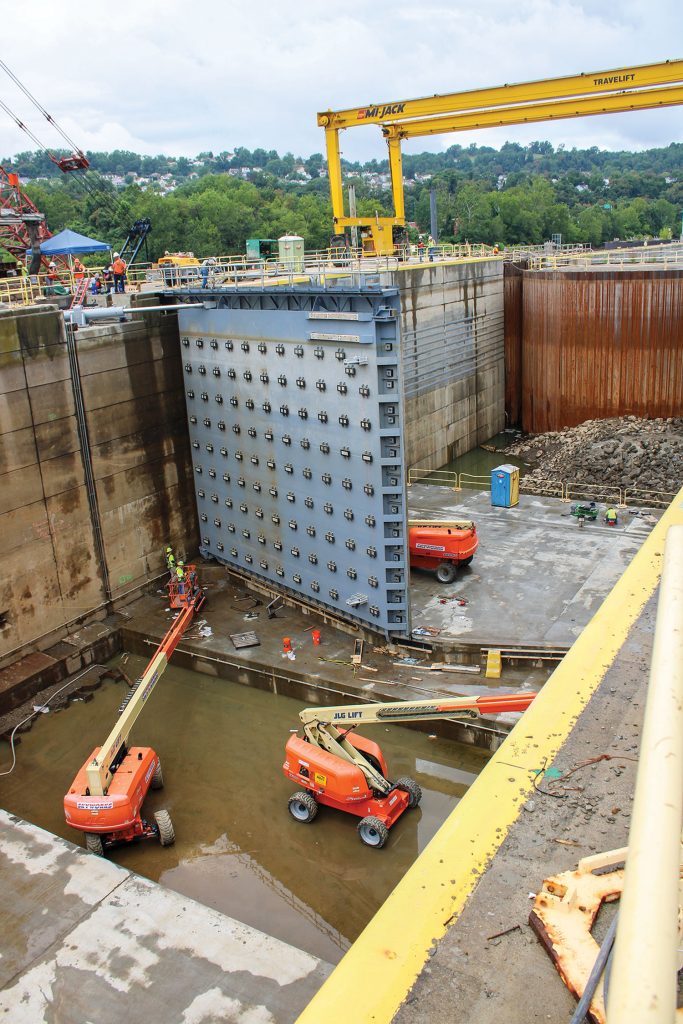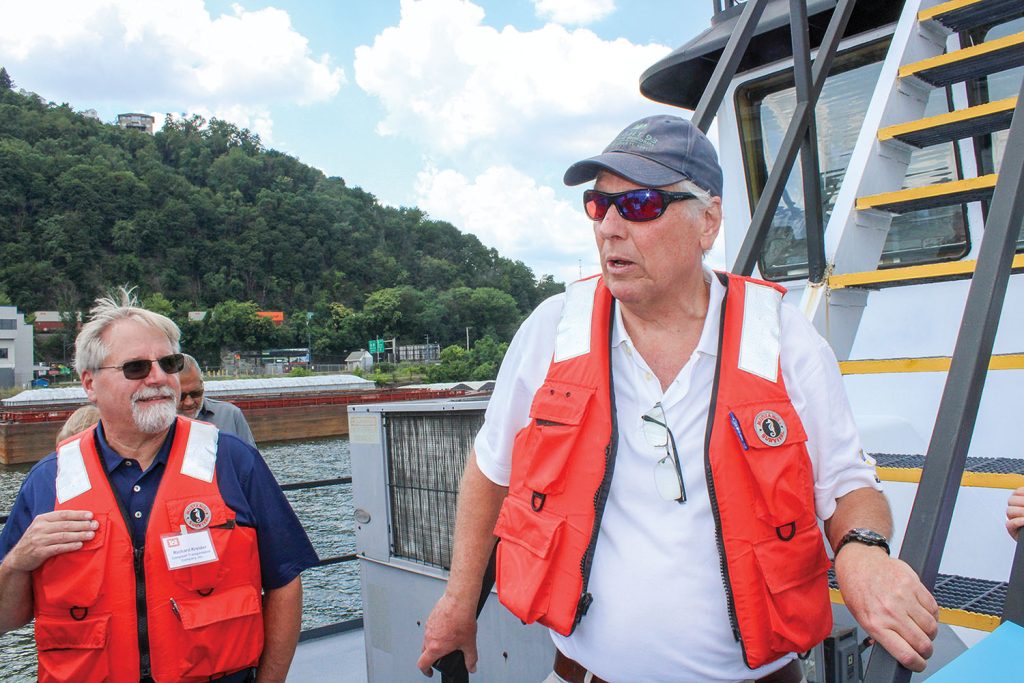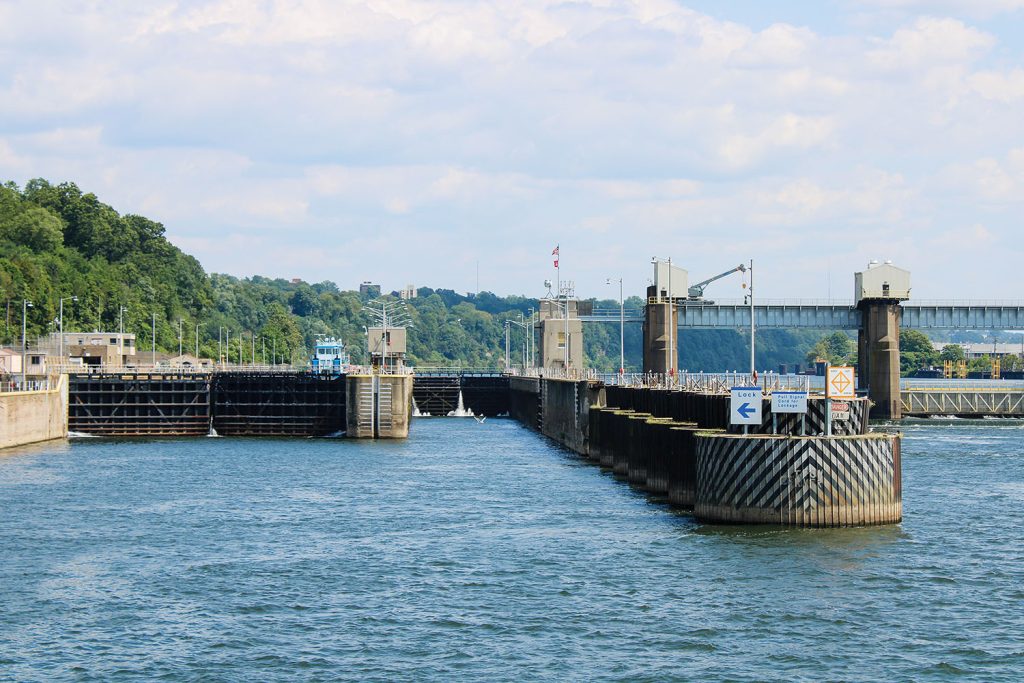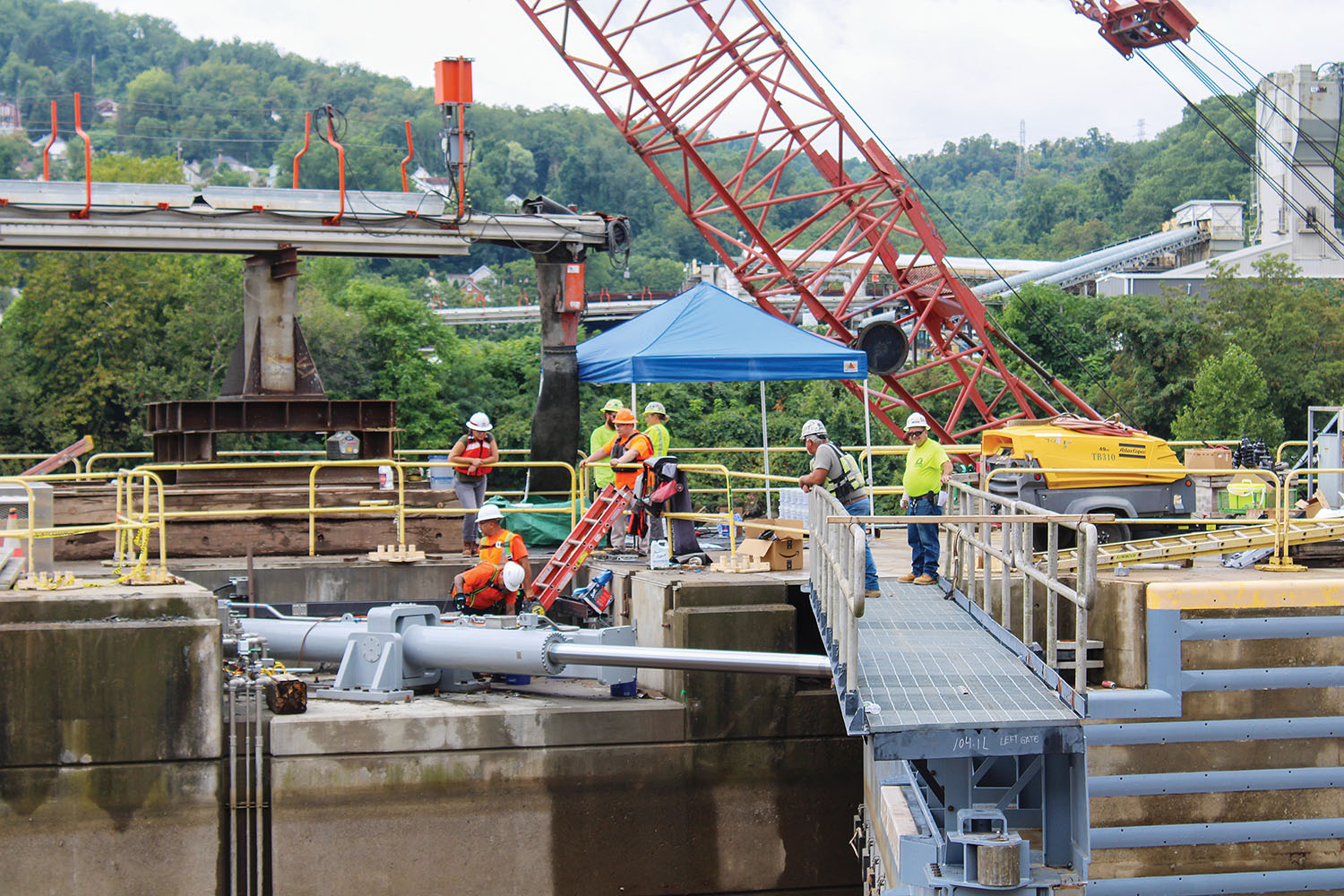Stressing the need for full and efficient funding for lock construction, Waterways Council Inc. hosted members of the media on a tour of Pittsburgh area projects August 9-11.
The tour, conducted in cooperation with Campbell Transportation Company, the Port of Pittsburgh Commission, the Corps of Engineers, American Consolidated Natural Resources (ACNR) Towing, the Waterways Association of Pittsburgh and others, began with a ride on a Campbell Transportation Company towboat the mv. Darrell L. It included a 12-mile roundtrip from the point where the Lower Monongahela and Allegheny rivers form the head of the Ohio River in downtown Pittsburgh, passing through the auxiliary chamber at Emsworth Locks and Dam (Ohio River Mile 6.2) both downbound and upbound.
Upper Ohio Project
Emsworth is part of the Upper Ohio Navigation Project, for which Corps officials broke ground on August 11 at Montgomery Locks and Dam (Mile 13.7) on August 11, with tour participants also attending that event.
The Upper Ohio Navigation Project involves replacing existing 360- by 56-foot auxiliary lock chambers with new 600- by 110-foot chambers at Emsworth, Montgomery and Dashields (Mile 13.3) locks. The new chambers will then be the same size as the existing main chambers at each project.
Lower Mon Project
Tour participants also toured the construction site at Lock and Dam 4 at Charleroi, part of the Lower Monongahela Project. The project involves work on a fixed-crest dam at Lock and Dam 2 at Braddock, which has already been completed, creation of a new, expanded riverside lock chamber at Charleroi and replacement of Lock and Dam 3 at Elizabeth with a navigable pass, creating one, 30.3-mile pool instead of separate 12.3- and 18-mile pools.

Work on the new lock chamber at Charleroi is approximately 95 percent complete, said Stephen Frost, project manager for the Pittsburgh Engineer District.
The new lock is now 720 feet long and 84 feet wide. Previously it was 360 feet long and 84 feet wide, meaning it took three hours and multiple cuts for a tow to lock through. Once completed, a typical commercial tow should be able to lock through in about 40 minutes, Frost said.
The district expected to fill the chamber with water for the first time within the next few days and then begin testing. The construction schedule calls for the chamber to become operational in January 2024 and the full contract at Charleroi to be complete in July 2024. In addition to the enlargement of the riverside lock chamber, work at Charleroi has included extending the Charleroi dam stilling basin, inland river dredging and some public shoreline facility relocations.
Once complete, the lock will be renamed after the late John P. Murtha, a longtime congressman and decorated Marine Corps veteran from western Pennsylvania.
Crews will soon move on to Elizabeth, where a contract for the dam’s removal in favor of a navigable pass was awarded last month.
Upon the riverside chamber at Charleroi becoming operational, the landside chamber is slated to close. Work that would allow continued operation of that chamber has been delayed until the 2050s, said Stephen Fritz, mega projects program manager for the Pittsburgh district. However, he added that Corps estimates show that even without a second operable chamber at Charleroi, 90 percent of the project’s economic benefits will be captured by the scope of the remaining work. Some industry representatives continue to express concerns about not having a second lock available, especially during unscheduled lock closures or periods of high water.
Aging Infrastructure
Throughout the tours, Corps and industry representatives spoke about how long projects were taking to build and how much more they cost because of inflation as they have had to wait decades in some cases between congressional authorization and sufficient appropriations to complete the work.
Most major construction and rehabilitation projects along the inland waterways system are funded 65 percent from the general treasury of the federal government and 35 percent from the Inland Waterways Trust Fund (IWTF), into which diesel tax fees paid by commercial users are deposited. The IWTF is the result of a self-imposed tax on the industry by the industry to help accelerate projects to cut down on unplanned closures at locks operating 50 years and more beyond their design lives.
The region’s locks are some of the most inefficient in the system, with towboat companies forced to split their tows into two or more cuts to traverse the lock, costing time and money.

“Those were small, old chambers that were built to the sizes at that time, which is very small,” said Richard Kreider, vice president of logistics for Campbell Transportation Company.
One example of that is the Elizabeth Lock and Dam on the Lower Mon, which opened in 1907, said Peter Stephaich, chairman and CEO of Campbell Transportation Company.
“The wood, 107-plus years [old], is fine, but the concrete is falling apart,” he said.
Each lock is unique, which means when a part on one of the chambers fails, a spare part can’t be shipped from another location. Fabrication takes time as the parts are no longer routinely available, and procurement times can be lengthy. Without enough funding to replace them, however, maintenance has been the only option. That will only last so long, however, Stephaich said.
Speaking candidly, he said, “If we don’t replace them, we’ll lose the whole system.”
Chris Dening, project manager for the construction of the Upper Ohio project, echoed that sentiment when speaking about the project recently.
“What makes this project critical is the potential for structural failure of the lock walls, which would cause major interruption to river transportation,” he said. “Many of the walls have significant cracking along and across their lengths. We have observed leaking within the lock walls during operation, which confirmed the seriousness of the situation.”
If one of the lock walls failed, it would impact operations for several months, Dening said. An unexpected failure would cause industry shippers to react, scrambling to find new ways to reroute shipments at the last minute.
It would also have economic and environmental effects. WCI notes that marine transportation is by far the most cost effective and most fuel-efficient form of transportation.
According to statistics provided by WCI, a rail car is 30 percent less efficient than a barge, and a tractor-trailer rig is 78 percent less efficient. Additionally, to move an identical amount of cargo by rail generates 43 percent more emissions than by barge. Trucks generate more than 800 percent more emissions.
Inflation Pressure
The longer projects have had to wait for funding, the more the cost has gone up. Stephaich said a new, 1,200-foot lock chamber can now be expected to cost about $2.5 billion, with 800-foot chambers in the $1 billion range.
New project cost estimates the Corps completed since the COVID-19 pandemic began—bringing with them associated supply chain and workforce issues—have found steeply increased project costs in several cases.
The cost for the new lock at Montgomery is one of those cases. While the Infrastructure Investment and Jobs Act (IIJA) was meant to fully fund the Montgomery project to completion, it is now expected to take an additional $513 million to complete it, more than doubling its cost.
The new lock at Charleroi, which is nearly finished, needs approximately another $43 million and is now expected to come in at a total cost of $1.23 billion, Frost said, citing preliminary figures. A new certified cost estimate at the project is due by the end of the year, Fritz said.
“We have ballpark numbers we’re going to be using, but we’re still really relying on that certified cost estimate,” he said.
When construction on the Lower Mon Project began nearly 30 years ago, it was expected to be much less, but funding came in only in drips, Frost said.
“There was a period when the funding was very sparse to the point where we had trouble keeping the resident [construction] office open,” he said.
While the work at Charleroi was originally expected to take one or two construction contracts, it is now expected to take about 15.
Federal Funding Sought
The IIJA funding was seen as the shot in the arm the Corps needed to finish many of the projects, not only in the Pittsburgh region but elsewhere, too. The Three Rivers project on the McClellan-Kerr Arkansas River Navigation System, Upper Mississippi Lock and Dam 25 and the Kentucky Lock Addition Project on the Tennessee River all had been expected to be funded to completion, but all will now cost significantly more, according to updated cost certifications. That finding led the Inland Waterways Users Board, an advisory board made up of industry representatives, to vote unanimously at its last meeting July 20 to recommend that the federal government pay for the entire cost overruns for all seven projects previously believed to be funded to completion through IIJA , with no additional money coming from the IWTF.
Dustin Davidson, director of government relations for WCI, would like to see that, too.
“That’s a priority of WCI,” he said.

WCI sees including increased federal appropriations as necessary to keep ongoing construction projects moving forward and to prevent long-delayed but congressionally authorized projects from becoming even more costly. The IWTF only has about $400 million a year to go toward these projects, Davidson said.
To fund all the projects already authorized, “We’re talking about billions,” said Jen Armstrong, WCI director of, government relations.
Along with regularly occurring appropriations, WCI is advocating for the federal government to pay more of its share of major projects. Ideally, WCI would like to see the remaining cost for the seven projects previously believed to be funded to completion in IIJA to be written into the next Waterways Resources and Development Act (WRDA) bill, which is traditionally passed every two years and due out in 2024. With no changes to the cost share structure, some of the projects already authorized and under construction could take 20 to 30 years to build, Armstrong said.
That is far too long, Davidson said, adding, “There is an annual benefit to the nation for these projects.”
Caption for top photo: Crews working in Charleroi Lock. (photo by Shelley Byrne)




